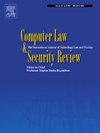AI-driven civil litigation: Navigating the right to a fair trial
IF 3.3
3区 社会学
Q1 LAW
引用次数: 0
Abstract
The integration of artificial intelligence (AI) into legal proceedings has gained significant traction in recent years, particularly following the Covid-19 pandemic. As part of the broader movement toward the digitalization of legal systems, AI is seen as a tool to improve access to justice, enhance efficiency, and adopt a human-centered approach. However, the rapid advancement of AI necessitates careful consideration of fundamental human rights, especially the right to a fair trial as enshrined in Article 6 of the European Convention on Human Rights (ECHR). Recently, the European Union's Artificial Intelligence Act classifies AI systems used in the judiciary as high-risk, requiring impact assessments on fundamental rights, including the right to a fair trial. This paper explores the impact of AI-driven judicial tools on the right to a fair trial, focusing on key components such as the right to be heard, judicial independence, impartiality, and the principle of publicity. This paper explores the impact of AI-driven judicial tools on the right to a fair trial, focusing on key components such as the right to be heard, judicial independence, impartiality, and the principle of publicity, while examining the risks and opportunities posed by AI in civil litigation, including challenges like algorithmic discrimination, digital exclusion, and the potential erosion of human judges' cognitive abilities.
人工智能驱动的民事诉讼:引导公平审判的权利
近年来,特别是在2019冠状病毒病大流行之后,人工智能(AI)与法律诉讼的结合取得了巨大进展。作为更广泛的法律系统数字化运动的一部分,人工智能被视为改善诉诸司法、提高效率和采取以人为本方法的工具。然而,人工智能的快速发展需要认真考虑基本人权,特别是《欧洲人权公约》(ECHR)第6条所载的公平审判权。最近,欧盟的《人工智能法案》将司法部门使用的人工智能系统列为高风险,要求对包括公平审判权在内的基本权利进行影响评估。本文探讨了人工智能驱动的司法工具对公平审判权的影响,重点关注了知情权、司法独立、公正性和公开原则等关键要素。本文探讨了人工智能驱动的司法工具对公平审判权的影响,重点关注了知情权、司法独立、公正性和公开原则等关键组成部分,同时研究了人工智能在民事诉讼中带来的风险和机遇,包括算法歧视、数字排斥和人类法官认知能力的潜在侵蚀等挑战。
本文章由计算机程序翻译,如有差异,请以英文原文为准。
求助全文
约1分钟内获得全文
求助全文
来源期刊
CiteScore
5.60
自引率
10.30%
发文量
81
审稿时长
67 days
期刊介绍:
CLSR publishes refereed academic and practitioner papers on topics such as Web 2.0, IT security, Identity management, ID cards, RFID, interference with privacy, Internet law, telecoms regulation, online broadcasting, intellectual property, software law, e-commerce, outsourcing, data protection, EU policy, freedom of information, computer security and many other topics. In addition it provides a regular update on European Union developments, national news from more than 20 jurisdictions in both Europe and the Pacific Rim. It is looking for papers within the subject area that display good quality legal analysis and new lines of legal thought or policy development that go beyond mere description of the subject area, however accurate that may be.

 求助内容:
求助内容: 应助结果提醒方式:
应助结果提醒方式:


